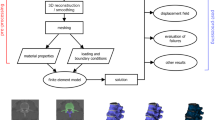Abstract
This article describes a number of new techniques useful for the construction of biomechanical and anatomical models, particularly those that employ combined FEM-multibody simulation. They are being introduced to the ArtiSynth mechanical modeling system, and include reduced coordinate modeling, in which an FEM model is made more computationally efficient by reducing it to a low degree-of-freedom subspace; new methods for connecting points and coordinate frames directly to deformable bodies; and the ability to create skin and embedded meshes that are connected to underlying FEM models and other dynamic components. All these techniques are based on the principle of virtual work, and we illustrate their application with a number of examples, including a reduced FEM tongue model, subject-specific skeletal registration, skinning applied to modeling the human airway, and a detailed model of the human masseter.
Access this chapter
Tax calculation will be finalised at checkout
Purchases are for personal use only
Similar content being viewed by others
References
An SS, Kim T, James DL (2008) Optimizing cubature for efficient integration of subspace deformations. ACM Trans Graph (TOG) 27(5):165
Anderson P, Fels S, Harandi NM, Ho A, Moisik S, Sánchez CA, Stavness I, Tang K (2017) Frank: s hybrid 3d biomechanical model of the head and neck. Biomechanics of living organs. Elsevier, Amsterdam, pp 413–447
Barbič J, James DL (2005) Real-time subspace integration for st. venant-kirchhoff deformable models. ACM Trans Graph (TOG) 24(3):982–990
Besl PJ, McKay ND (1992) Method for registration of 3-d shapes. In: Sensor fusion iv: control paradigms and data structures, vol 1611. International Society for Optics and Photonics, pp 586–607
Bonet J, Wood RD (2008) Nonlinear continuum mechanics for finite element analysis. Cambridge University Press, Cambridge
Buchaillard Stéphanie, Perrier Pascal, Payan Yohan (2009) A biomechanical model of cardinal vowel production: muscle activations and the impact of gravity on tongue positioning. J Acoust Soc Am 126(4):2033–2051
Faure F, Duriez C, Delingette H, Allard J, Gilles B, Marchesseau S, Talbot H, Courtecuisse H, Bousquet G, Peterlik I et al (2012) Sofa: a multi-model framework for interactive physical simulation. Soft tissue biomechanical modeling for computer assisted surgery. Springer, Berlin, pp 283–321
Hermant N, Perrier P, Payan Y (2017) Human tongue biomechanical modeling. Biomechanics of living organs. Elsevier, Amsterdam, pp 395–411
Kim SY, Boynton EI, Ravichandiran K, Fung LY, Bleakney R, Agur AM (2007) Three-dimensional study of the musculotendinous architecture of supraspinatus and its functional correlations. Clin Anat Off J Am Assoc Clin Anat Br Assoc Clin Anat 20(6):648–655
Krysl P, Lall S, Marsden JE (2001) Dimensional model reduction in non-linear finite element dynamics of solids and structures. Int J Numer Methods Eng 51(4):479–504
Lee Dongwoon, Ravichandiran Kajeandra, Jackson Ken, Fiume Eugene, Agur Anne (2012) Robust estimation of physiological cross-sectional area and geometric reconstruction for human skeletal muscle. J Biomech 45(8):1507–1513
Lloyd JE, Stavness I, Fels S (2012) Artisynth: a fast interactive biomechanical modeling toolkit combining multibody and finite element simulation. Soft tissue biomechanical modeling for computer assisted surgery. Springer, Berlin, pp 355–394
Nesme M, Kry PG, Jeřábková L, Faure F (2009) Preserving topology and elasticity for embedded deformable models. ACM Trans Graph (TOG) 28:52 ACM
Pentland A, Williams J (1989) Good vibrations: modal dynamics for graphics and animation. Comput Graph 23(3):207–214
Perrier A, Luboz V, Bucki M, Cannard F, Vuillerme N, Payan Y (2017) Biomechanical modeling of the foot. Hyperelastic constitutive laws for finite element modeling. Biomechanics of living organs. Academic Press, Cambridge, pp 545–563
Sánchez CA, Li Z, Hannam AG, Abolmaesumi P, Agur A, Fels S (2017) Constructing detailed subject-specific models of the human masseter. Imaging for patient-customized simulations and systems for point-of-care ultrasound. Springer, Berlin, pp 52–60
Sanchez CA, Lloyd JE, Li Z, Fels S (2015) Subject-specific modelling of articulated anatomy using finite element models. In: Proceedings of 13th international symposium on computer methods in biomechanics and biomedical engineering (CMBBE)
Sanchez CA, Stavness I, Lloyd JE, Hannam AG, Fels S (2014) Modelling mastication: the important role of tendon in force transmission. In: Proceedings of 12th international symposium on computer methods in biomechanics and biomedical engineering (CMBBE)
Schenk Olaf, Gärtner Klaus (2004) Solving unsymmetric sparse systems of linear equations with pardiso. Futur Gener Comput Syst 20(3):475–487
Sifakis E, Barbic J (2012) FEM simulation of 3d deformable solids: a practitioner’s guide to theory, discretization and model reduction. In: Proceedings of ACM SIGGRAPH 2012 courses. ACM, p 20
Stavness I, Sánchez CA, Lloyd J, Ho A, Wang J, Fels S, Huang D (2014) Unified skinning of rigid and deformable models for anatomical simulations. In: Proceedings of SIGGRAPH Asia 2014 technical briefs. ACM, p 9
von Tycowicz C, Schulz C, Seidel H-P, Hildebrandt K (2013) An efficient construction of reduced deformable objects. ACM Trans Graph 32(6):213:1–213:10
Author information
Authors and Affiliations
Corresponding author
Editor information
Editors and Affiliations
Rights and permissions
Copyright information
© 2019 Springer Nature Switzerland AG
About this chapter
Cite this chapter
Lloyd, J.E. et al. (2019). New Techniques for Combined FEM-Multibody Anatomical Simulation. In: Tavares, J., Fernandes, P. (eds) New Developments on Computational Methods and Imaging in Biomechanics and Biomedical Engineering. Lecture Notes in Computational Vision and Biomechanics, vol 33. Springer, Cham. https://doi.org/10.1007/978-3-030-23073-9_6
Download citation
DOI: https://doi.org/10.1007/978-3-030-23073-9_6
Published:
Publisher Name: Springer, Cham
Print ISBN: 978-3-030-23072-2
Online ISBN: 978-3-030-23073-9
eBook Packages: Biomedical and Life SciencesBiomedical and Life Sciences (R0)




